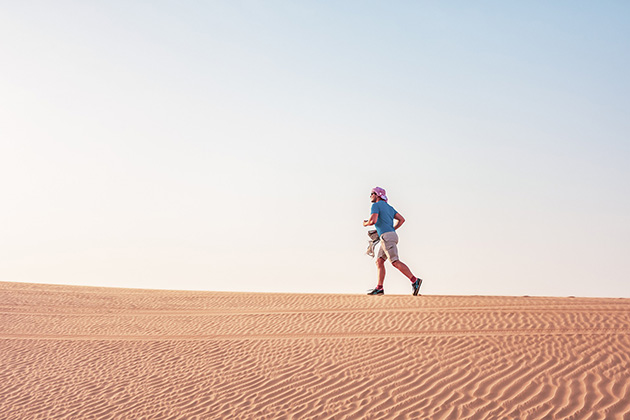This article summarizes my dealing with an athlete preparing for the grueling ultra marathon event, Marathon Des Sables or Marathon of the Sands.
About the Race
The Marathon Des Sables is a multi-day long-distance endurance race, held in the desert of Morocco. In 2007 it was a seven day event with the following distances to cover each day: Day 1: 28km, Day 2: 38km, Day 3: 38km, Day 4: 80km, Day 5: rest day, Day 6: 42km, Day 7: 20km. See more about the Marathon des Sables.
In the Moroccan desert in April, when the event is held, the day time heat can be very high (up to 40oC), while it can also be very cold at night in the desert. Not only that, the runners must carry their own food and equipment for whole race. They must have a minimum of 2000 calories (8360kJ) per day, which is checked by officials at the beginning of the race.
Considerations
Most of the athletes arrive in Morocco for the week prior to the start of the event to acclimatize, and will want to start carbohydrate loading about three days prior to the start of the race. In the heat there is an increase in fluid needs, as well as an increase in carbohydrate utilization which both need to be considered.
Another very important consideration is the food safety. Local water in Morocco is usually unsafe and needs to be avoided. Food will also carry risks for infections and athletes need to be careful with their choices. Clean bottled drinking water is supplied for the race, however all the food would need to be brought with the athlete from elsewhere, and stored safely in the hot conditions prior to and for the duration of the race.
As the runners are required to carry their own food, the weight and energy density of the food must be optimized. The diet plan must factor in the minimum carbohydrate needs, the minimum energy required to minimize weight loss for the 7 days, and fluid and electrolyte needs based on calculated sweat losses.
Diet Recommendations
This runner requested a maximum of 500g of food per day. In addition to minimizing the weight of the food to be carried, it was important to consider the athletes energy requirements, to estimate the ideal carbohydrate to fat ratio, and any supplements that may be required. Food options considered included porridge for breakfast, Sustagen, chocolate, dried fruit, kettle chips, and pre-packages dried meals. Other high energy food ideas; nuts, gels, sports drink, fruit cake, cheetos, pringles, jelly beans, olive oil added to dinners to increase energy density.
The average energy needs for this athlete was calculated at 16,500 kJ/day, taking into account his body size and his expected pace for the race. The minimum energy needed to get away with allowable weight loss during the race was 10,500kJ (2500cal). The optimal grams of carbohydrate/fat/protein nutrients for each day to fit in with the limit of 500g of food per day was roughly 330g/100g/90g. The challenge was rearranging the food options to best balance energy, carbohydrate, sodium, fluid, while also considering taste!
 running in the desert
running in the desert Carbohydrate loading pre-race: 10g of carbohydrate per kilogram of body weight per day is recommended for the 2 - 3 days prior to the race. For this runner it worked out to be 680g (based on a weight of 68 kg). The athlete was provided with a carbohydrate counter to work out his daily intake. As he was going to be in Morocco for this time, he needed to consider what food he would bring from home, and what food he could find in Morocco.
During the event, one third of the daily food ration was to be eaten in the morning prior to the start, one third for snacks during the run, and one third for post race dinner. The breakfast meal was to have a higher proportion of carbohydrate to ensure the best fuels for running, while the evening dinner meal contained a higher proportion of fat to regain higher amounts of energy that were lost during the day.
Salt and Hydration
Clean drinking water is provided to all the competitors: 1.5 liters at each 10km point, plus 4 liters at the end of each day. Glycerol hyper-hydration was also an option to optimize body water stores prior to the race start.
A review of daily sodium needs determined that the minimum requirement was 1000mg/day plus 1g/hour of exercise, ranging from 4000mg up to 11,000mg depending on the speed and distance covered on each race day. The option to use salt tablets or loose salt to add to food was also considered. Salt tablets were being provided during the race, but sodium could also be added to meals, in addition to being provided via sports drinks. Optimizing salt intake while also considering thirst and palatability of foods is necessary. It is ideal that athletes trial taking salt tablets during running to see the effect on their gastrointestinal system. It was decided to use Staminade sports drink due to its weight (55g of Staminade makes 1 liter, whereas 80g Gatorade makes 1 liter) as shaving as much weight as possible is crucial.
Conclusion
The athlete completed the race, and performed better than he expected, finishing in the top 100. He even wants to do another one! The only changes he would want to make would be to include an extra 500 grams of food. In addition to the salt that had been decided upon, he had added an extra gram per 10km after the second day due to ongoing cramps and it seemed to help.



